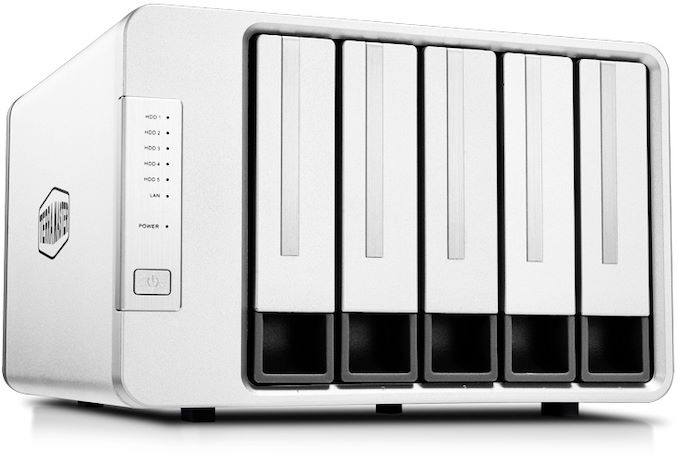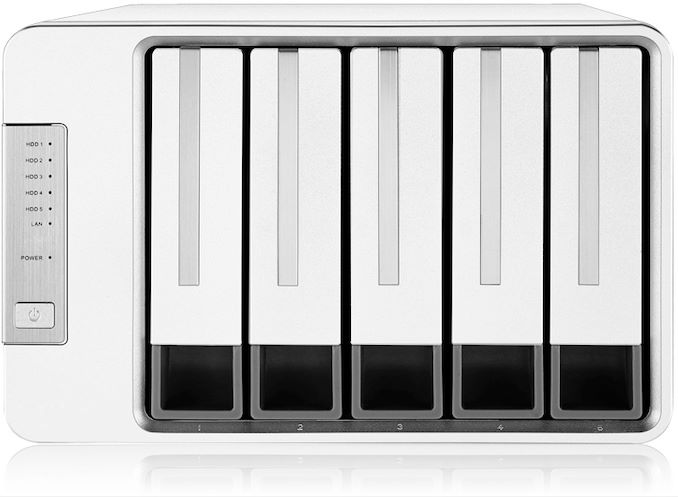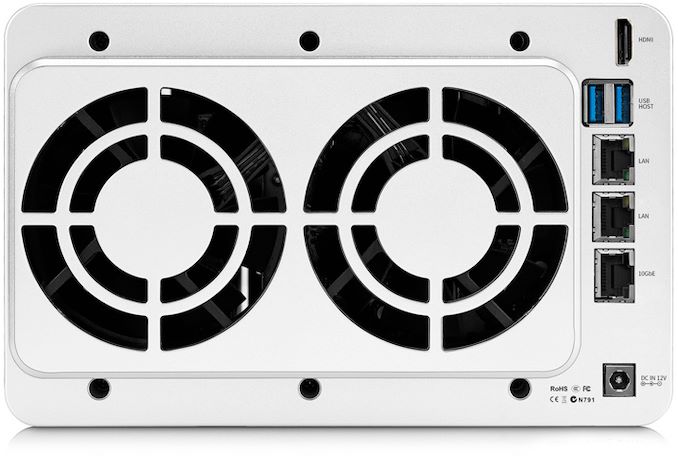CES 2020: TerraMaster Shows Off 5-Bay F5-422 NAS with 10 Gb Ethernet
by Anton Shilov on January 17, 2020 1:00 PM EST- Posted in
- NAS
- Storage
- Trade Shows
- TerraMaster
- CES 2020

TerraMaster unveiled a new five-bay NAS with a 10 GbE connectivity at this year's CES. The F5-422 is based upon Intel Apollo Lake SoC, and runs the company’s TOS 4.1 operating system on top of it, supporting up to 5 3.5-inch drives.
The TerraMaster F5-422 is powered by Intel’s Celeron J3455 quad-core SoC (1.5 GHz – 2.3 GHz) that is paired with 4 GB of memory (expandable to 12 GB). The unit can accommodate five 3.5-inch/2.5-inch hard drives or solid-state drives, which means with today's largest 16 TB HDDs, the NAS can accommodate a total of 80 TB in storage. And, as you'd expect for a modern NAS, the F5-422 supports various RAID modes, including RAID 1, RAID 5, RAID 6, and RAID 10.
Once released, the F5-422 NAS will be one of a handful of prosumer NASes on the market with support for high speed Ethernet, thanks to its one 10 GbE port. As well, the NAS supports two 1 GbE connectors, two USB 3.0 ports, and an HDMI display output. Though it should be noted that despite presence of an HDMI port, the NAS is not designed to work as a media player.
From performance point of view, the NAS is rated to read data at up to 670 MB/s speed as well as write data at up to 650 MB/s when all of its drives operate in RAID 5 mode. Meanwhile, TOS 4.1 OS supports SSD caching to accelerate I/O performance. The NAS can be used by large companies as it supports concurrent access for up to 500 users.
In addition to AES-NI and RAID modes, TerraMaster’s F5-422 with TOS 4.1 supports multiple security layers, including clustered Btrfs file system and snapshots as well as scheduled backups (including an option to back up to the cloud).
TerraMaster will begin selling the F5-422 shortly. Prices will vary with the configuration.
Related Reading:
- QNAP Unveils HS-453DX Silent NAS: Two HDDs, Quad-Core SoC, HDMI 2.0, 10 GbE
- QNAP Announces TS-332X Three-Bay NAS with 10 GbE
- QNAP Launches 16-Bay AMD Ryzen-Based TS-1677X NAS with 10 GbE
- Synology Introduces DiskStation DS1618+ with Intel Denverton
- Next-Gen NAS: An Interview with Alex Wang, CEO of Synology America
- QNAP Launches TS-963X NAS: x86 NAS With 9 Bays & 10 GbE/Multi-Gig Ethernet
Source: TerraMaster












33 Comments
View All Comments
close - Monday, January 20, 2020 - link
Also if you plan on having 1500 users doing small writes, transcoding 8K to 1080p, and compressing binaries using xz and the extreme profile it will probably not be enough. o_OBut seriously though, if your use case requires SSD for caching, transcoding, and compressing enough of the time (not just the occasional peak) to justify the hardware then you're looking at the wrong NAS to begin with.
I have a machine with J1900 that serves a home, does some additional firewalling, pulls NAS duty, VPN server, transcoding from 1080p to 720p, and the occasional experiment of all sorts and I can say I don't feel limited in all but a very few corner cases. And they're definitely not able to justify running a larger, hotter, more power hungry box at all times.
You have to pick you HW for what you need and it will cost. That HW that costs pennies, is free to maintain forever, but has more processing power than a football field sized supercomputer is currently out of stock.
timecop1818 - Friday, January 17, 2020 - link
You don't need "more power" but I'd rather see these with a real hardware raid chip instead of doing software lunix raid.antonkochubey - Saturday, January 18, 2020 - link
How is hardware RAID any more "real" than software RAID? You're executing same tasks on a different CPU, which nowadays is completely needless as general purpose CPUs are powerful enough for simple XORing ;)timecop1818 - Wednesday, January 22, 2020 - link
The part where it doesn't involve a hobby operating system and the part where entire array is presented as a single drive to the OS.tmanini - Saturday, January 18, 2020 - link
out of curiosity - what features do you use that are hardware RAID specific ?timecop1818 - Wednesday, January 22, 2020 - link
RAID6, spare drive(s), availability of entire array as a block device to the OS, not running a hobby operating system in order to be able to use the drives. Not wasting CPU power on software calculations for raid.sdoorex - Friday, January 17, 2020 - link
Starts at $600Valantar - Friday, January 17, 2020 - link
With 10GbE? While that's still enough to get a 10GbE card alongside a decent ITX board, cheap CPU far superior to this, Ram, PSU and case (though without hot-swap and much larger) that's not as bad as I would have thought. Still, I'd much rather go the DIY route.oRAirwolf - Saturday, January 18, 2020 - link
While I agree with you and have 4 DIY NAS machines, I think you are kind of missing the point of these things. They aren't meant for people who can build their own NAS. They are meant for those who need a file server that works out of the box with little configuration These also come with a warranty and tech support. DIY does not.Valantar - Saturday, January 18, 2020 - link
Absolutely. It's just that that market is rather small. The featureset is too limited for most SMBs, and the price is far too high for most consumers. With DIY-capable enthusiasts also excluded, the target market for this seems limited to home users with a lot of money, not that much time, a desire for 10GbE, but no desire for transcoding capabilities or other somewhat heavy loads. Meaning... rich photography enthusiasts, I guess? Not that there aren't many of those, but it's still ultimately a tiny market.The NAS market needs to reach commodity pricing levels to increase sales, but can't get there by cutting features or performance -that'll just turn people off the idea and make them pay for cloud storage instead.